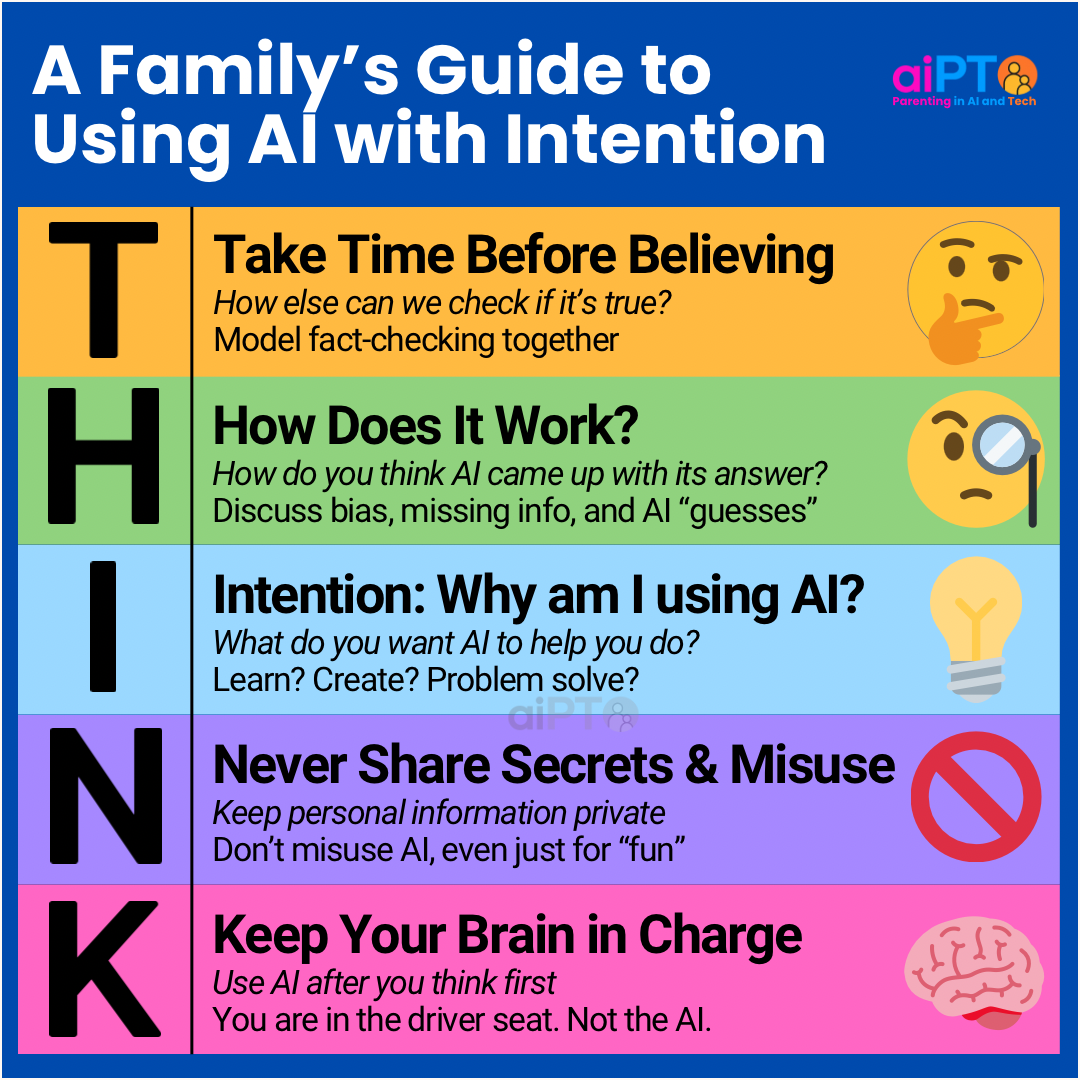How I Almost Let AI Write My Newsletter
An Honest Guide To Help Families Use AI With Intention
I almost let a GenAI tool write this week’s post.
Between the increasing work deadlines and family life, I‘ve been struggling to keep up with my usual writing rhythm.
I had another topic and outline prepped, and was ready to ask an AI tool to run with it. So, I typed my prompt:
“Write a 1,500 words article for parents titled ’Growing up in a post reality world’. Here’s the outline….”.
As soon as I hit enter, something felt wrong. In just seconds, a whole article appeared.
Sure, it followed my structure but it wasn’t my voice.
Sure, I could have trained it to mimic “my tone” but it doesn‘t feel genuine.
Sure, there were some catchy stories and phrases in there, but those never happened.
I realized what’s happening. It’s me, taking a short cut.
I’ve told my kids, and readers, literally last week that the science is clear:
When we use AI as a shortcut, it can erode confidence, motivation, and independent problem-solving skills.
If I want to continue modeling thoughtful tech use for my kids, this was the moment. So, I closed my iPad and walked away.
As I tried to fall asleep that night, I thought:
I can’t be the only one struggling to not take a shortcut, especially in a pinch.
There has to be a better way.
Time for a New Question
The next day I thought:
Now there’s no shortage of content around AI tools and prompts. But, as a parent, I feel like there’s something missing.
As AI becomes a convenient path, how do I help my kids to pause, ask and decide:
Is this the right time for AI?
If yes, what’s the right way to use AI?
The question of agency, not literacy.
If AI is shaping my day by default and unconsciously nudging me to use it before my own brain, what’s the point of knowing how it works?
That’s when I decided to try something different.
I made up my mind to write about this and finish no matter what as I don‘t have any more time this week.
I started with a sprint: 15 minutes drafting. Putting all my thoughts down. Then I leveraged AI to be my editor, not an unsolicited ghostwriter.
I told it to “Be an honest, objective, and critical editor. Do not change my wording or invent stories or examples that don't exist in the draft. Just give feedback”
And, it gave me some useful feedback:
How I started strong with my personal story.
Then, veered off to some conceptual frameworks (Yes, I do love frameworks!)
How I go on a tangent in the middle that breaks my narrative flow.
While there were still suggested changes, I saw no new made-up examples. Just feedback, which is what I wanted.
I took the feedback that makes sense and repeated my steps: 15 minutes drafting. Then iterate with my “editor” without any rewrite until I felt happy with my version.
This is the AI partnership that I want to model, where the thinking stayed mine.
What Human-AI Agency Can Look Like at Home
Going back to the point of this post, how do we empower ourselves and our kids to own the decisions on how and when we use AI so we don't all fall into the shortcut temptation.
Here’s what I think the path to stronger agency could look like through my THINK framework.
T - Take Time Before Believing
We are often exposed to AI regardless of whether we choose it or not.
Whenever I get an AI answer from Google on a question my daughter asked, I say out loud, “Hmm let’s double check the sources to this answer,” because I want her to see the habit of fact-checking.
H - How Does It Work?
As we begin to recognize when AI is being used and how it works or impacts us, we are building our kids’ AI literacy.
I asked my kindergartner, “How do you think YouTube Kids recommend these videos to you?” Then we’ll discuss her videos history, explain how the computer ”guess” what other similar videos she might also like.
For older kids, you can talk about bias, missing information, and hallucination that’s inherent in GenAI. If you’re looking for ideas, I wrote about how you can explain GenAI for different age group in this prior newsletter edition.
I - Intention
Once we choose to use AI, we aim for purposeful use.
Keep this simple. Here’s some questions I ask myself:
Do I need a sparring partner or editor or teacher?
Am I trying to build something but lack certain skills that AI can augment?
Is AI the right tool for this tasks/ goal?
N - Never Share Secrets or Use With Bad Intent
Just like how we warn kids not to share info to strangers, teach them to not share it with AI or any Chatbot.
Equally important is remind our kids to never misuse AI, even if they think is just a friendly prank.
K - Keep Our Brain in Charge
Here’s how we can gain our agency: We lead how AI fits into our lives, not the other way around.
Use AI after you use your brain and to improve your thoughts (not replace it or as a default).
Start with the fundamentals: Train them to have confidence in their own brain.
Delay the ”instant help”. As I wrote here, sometimes our kids need to feel the discomfort of not knowing or the struggle to get to the finish line.
Let’s Make This the Norm
Here’s the reality.
AI is going to be part of our kids’ world, whether we opt in or not. But how they use it, and how often they question it, can still be shaped by us.
This week, try asking:
“Is this the right moment for AI? If yes, is this the best way to use it?”
Then invite your kids to do the same.
Dhani






Hi Dhani, yes AI is a temptation, it’s polite, it offers to help — “just say the word and I draft you an article for substack if you’d like”, and it produces really really good results.
So bring discipline to resist is important, especially with the kids.
Great job!
This is so thoughtful and helpful! Thank you!